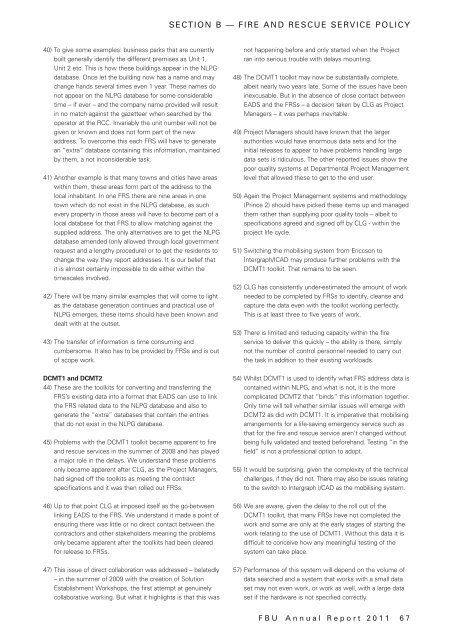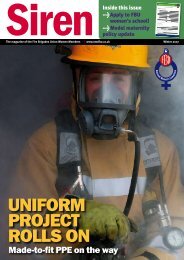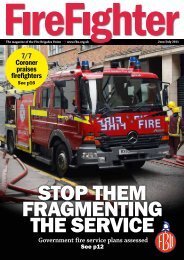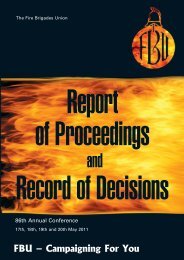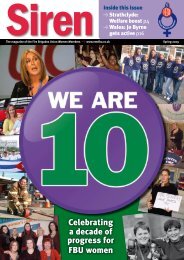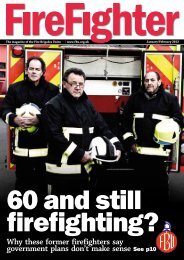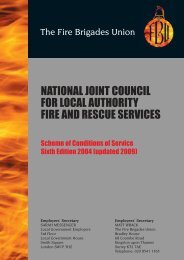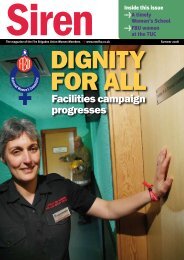Report - Fire Brigades Union
Report - Fire Brigades Union
Report - Fire Brigades Union
You also want an ePaper? Increase the reach of your titles
YUMPU automatically turns print PDFs into web optimized ePapers that Google loves.
SECTION B — FIRE AND RESCUE SERVICE POLICY<br />
40) To give some examples: business parks that are currently<br />
built generally identify the different premises as Unit 1,<br />
Unit 2 etc. This is how these buildings appear in the NLPG<br />
database. Once let the building now has a name and may<br />
change hands several times even 1 year. These names do<br />
not appear on the NLPG database for some considerable<br />
time – if ever – and the company name provided will result<br />
in no match against the gazetteer when searched by the<br />
operator at the RCC. Invariably the unit number will not be<br />
given or known and does not form part of the new<br />
address. To overcome this each FRS will have to generate<br />
an “extra” database containing this information, maintained<br />
by them, a not inconsiderable task.<br />
41) Another example is that many towns and cities have areas<br />
within them, these areas form part of the address to the<br />
local inhabitant. In one FRS there are nine areas in one<br />
town which do not exist in the NLPG database, as such<br />
every property in those areas will have to become part of a<br />
local database for that FRS to allow matching against the<br />
supplied address. The only alternatives are to get the NLPG<br />
database amended (only allowed through local government<br />
request and a lengthy procedure) or to get the residents to<br />
change the way they report addresses. It is our belief that<br />
it is almost certainly impossible to do either within the<br />
timescales involved.<br />
42) There will be many similar examples that will come to light<br />
as the database generation continues and practical use of<br />
NLPG emerges, these items should have been known and<br />
dealt with at the outset.<br />
43) The transfer of information is time consuming and<br />
cumbersome. It also has to be provided by FRSs and is out<br />
of scope work.<br />
DCMT1 and DCMT2<br />
44) These are the toolkits for converting and transferring the<br />
FRS’s existing data into a format that EADS can use to link<br />
the FRS related data to the NLPG database and also to<br />
generate the “extra” databases that contain the entries<br />
that do not exist in the NLPG database.<br />
45) Problems with the DCMT1 toolkit became apparent to fire<br />
and rescue services in the summer of 2008 and has played<br />
a major role in the delays. We understand these problems<br />
only became apparent after CLG, as the Project Managers,<br />
had signed off the toolkits as meeting the contract<br />
specifications and it was then rolled out FRSs.<br />
46) Up to that point CLG at imposed itself as the go-between<br />
linking EADS to the FRS. We understand it made a point of<br />
ensuring there was little or no direct contact between the<br />
contractors and other stakeholders meaning the problems<br />
only became apparent after the toolkits had been cleared<br />
for release to FRSs.<br />
47) This issue of direct collaboration was addressed – belatedly<br />
– in the summer of 2009 with the creation of Solution<br />
Establishment Workshops, the first attempt at genuinely<br />
collaborative working. But what it highlights is that this was<br />
not happening before and only started when the Project<br />
ran into serious trouble with delays mounting.<br />
48) The DCMT1 toolkit may now be substantially complete,<br />
albeit nearly two years late. Some of the issues have been<br />
inexcusable. But in the absence of close contact between<br />
EADS and the FRSs – a decision taken by CLG as Project<br />
Managers – it was perhaps inevitable.<br />
49) Project Managers should have known that the larger<br />
authorities would have enormous data sets and for the<br />
initial releases to appear to have problems handling large<br />
data sets is ridiculous. The other reported issues show the<br />
poor quality systems at Departmental Project Management<br />
level that allowed these to get to the end user.<br />
50) Again the Project Management systems and methodology<br />
(Prince 2) should have picked these items up and managed<br />
them rather than supplying poor quality tools – albeit to<br />
specifications agreed and signed off by CLG - within the<br />
project life cycle.<br />
51) Switching the mobilising system from Ericcson to<br />
Intergraph/ICAD may produce further problems with the<br />
DCMT1 toolkit. That remains to be seen.<br />
52) CLG has consistently under-estimated the amount of work<br />
needed to be completed by FRSs to identify, cleanse and<br />
capture the data even with the toolkit working perfectly.<br />
This is at least three to five years of work.<br />
53) There is limited and reducing capacity within the fire<br />
service to deliver this quickly – the ability is there, simply<br />
not the number of control personnel needed to carry out<br />
the task in addition to their existing workloads.<br />
54) Whilst DCMT1 is used to identify what FRS address data is<br />
contained within NLPG, and what is not, it is the more<br />
complicated DCMT2 that “binds” this information together.<br />
Only time will tell whether similar issues will emerge with<br />
DCMT2 as did with DCMT1. It is imperative that mobilising<br />
arrangements for a life-saving emergency service such as<br />
that for the fire and rescue service aren’t changed without<br />
being fully validated and tested beforehand. Testing “in the<br />
field” is not a professional option to adopt.<br />
55) It would be surprising, given the complexity of the technical<br />
challenges, if they did not. There may also be issues relating<br />
to the switch to Intergraph I/CAD as the mobilising system.<br />
56) We are aware, given the delay to the roll out of the<br />
DCMT1 toolkit, that many FRSs have not completed the<br />
work and some are only at the early stages of starting the<br />
work relating to the use of DCMT1. Without this data it is<br />
difficult to conceive how any meaningful testing of the<br />
system can take place.<br />
57) Performance of this system will depend on the volume of<br />
data searched and a system that works with a small data<br />
set may not even work, or work as well, with a large data<br />
set if the hardware is not specified correctly.<br />
FBU Annual <strong>Report</strong> 2011 67


